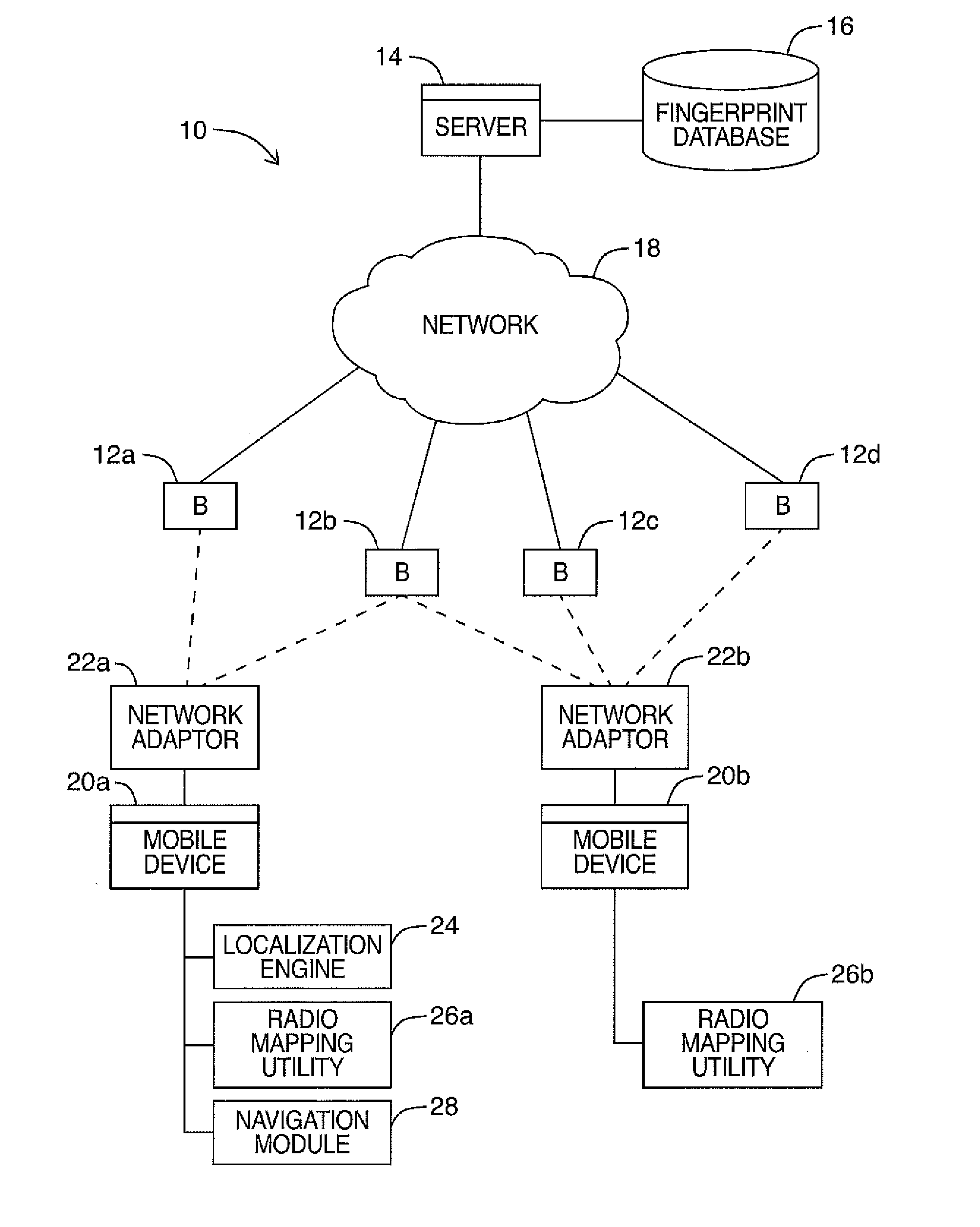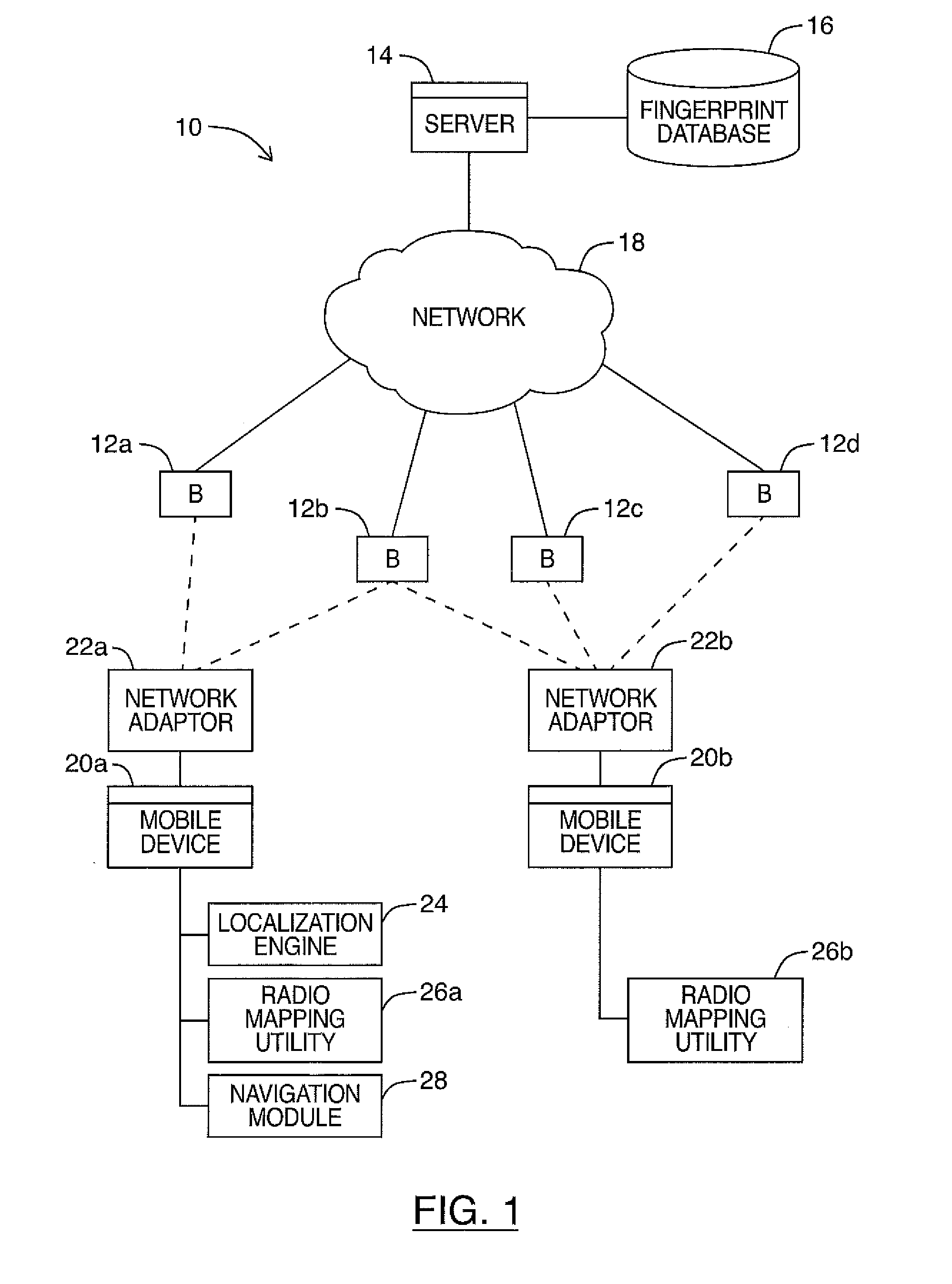System, method and computer program for dynamic generation of a radio map
a radio map and computer program technology, applied in the field of dynamic radio map generation, can solve the problems of difficult to provide a satisfactory level of accuracy for most locating applications, hardware installation or modification, unpredictable radio propagation channel, etc., and achieve satisfactory level of localization accuracy, reduce labor cost of fingerprint collection significantly, and evaluate performance
- Summary
- Abstract
- Description
- Claims
- Application Information
AI Technical Summary
Benefits of technology
Problems solved by technology
Method used
Image
Examples
example # 1
Example #1
[0195]Real data were obtained from an office building. Specifically, the experiments were carried out on a 30 m×46 m area of the fourth floor of an eight-story building (Bahen Center at the University of Toronto). A total of 26 beacons 12 were detected throughout the area of interest.
[0196]A personal digital assistant (PDA) or mobile device (HP iPAQ hx4700 with Windows Mobile 2003 pocket PC) was used to measure WLAN signal strength value, and a software was developed in Visual Studio C# to implement the CS-based positioning system on the device. The RSS values were collected on the device by using the open source library OpenNetCF, which provides access to MAC address and RSS values of WLAN APs. During the offline phase, the RSS observations from 26 beacons 12 were recorded for a period of 50 seconds (one sample per second) over 72 reference points with an average grid spacing of 1.5 m. At each reference point, RSS values from four orientations were recorded. The online ob...
example # 2
Example #2
[0207]A software application (e.g. indoor location resources) was developed on mobile devices 20 installed with Windows Mobile platform to implement the proposed indoor tracking and navigation system. The software was developed in C# using Microsoft .Net Compact Framework version 3.5. In addition, two open source libraries: OpenNetCF and DotNetMatrix were used to provide the RSS scanning function and matrix operations to the program. The software was tested on a mobile device 20 (e.g. PDA) manufactured by HP, hp iPAQ hx2750. The overview of the software and configured hardware is illustrated in FIG. 12.
[0208]The location determination system with prediction was tested at the second floor of the Canadian National Institute for the Blind (CNIB) with area dimensions of 18 m×36 m. During the offline phase, the developed software was run on the PDA to collect 100 RSS time samples for each of four orientations: North, East, South and West (with the sampling rate of 1 sample per ...
example # 3
Example #3
[0217]The embodiments described herein for generating a radio map dynamically may be implemented as a computer system that implements the disclosed techniques.
[0218]The embodiments described herein may be further applied in a number of practical systems that utilize the radio map prediction mechanism provided in this disclosure.
[0219]For example, a system and method may be constructed using the radio map prediction mechanism of the embodiments described herein that is configured to quickly monitor a person's location in an indoor environment to provide better security and protection services. Such a system may be used for example to monitor the location of a child in a kindergarten, a patient in a hospital, an elderly in an open indoor area, etc.
[0220]In another possible application of the system and method disclosed, a computer system may be configured to dynamically generate a radio map covering an indoor or outdoor area associated with one or more smart TVs. The compute...
PUM
 Login to View More
Login to View More Abstract
Description
Claims
Application Information
 Login to View More
Login to View More - R&D
- Intellectual Property
- Life Sciences
- Materials
- Tech Scout
- Unparalleled Data Quality
- Higher Quality Content
- 60% Fewer Hallucinations
Browse by: Latest US Patents, China's latest patents, Technical Efficacy Thesaurus, Application Domain, Technology Topic, Popular Technical Reports.
© 2025 PatSnap. All rights reserved.Legal|Privacy policy|Modern Slavery Act Transparency Statement|Sitemap|About US| Contact US: help@patsnap.com



